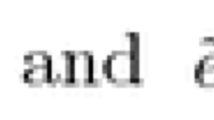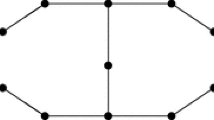Abstract
The hexagonal structure for ‘the geometry of logical opposition’, as coming from Aristoteles–Apuleius square and Sesmat–Blanché hexagon, is presented here in connection with, on the one hand, geometrical ideas on duality on triangles (construction of ‘companion’), and on the other hand, constructions of tripartitions, emphasizing that these are exactly cases of borromean objects. Then a new case of a logical interest introduced here is the double magic tripartition determining the semi-ring \({\mathcal{B}_3}\) and this is a borromean object again, in the heart of the semi-ring \({{\rm Mat}_{3}(\mathbb{B}_{\rm Alg})}\) . With this example we understand better in which sense the borromean object is a deepening of the hexagon, in a logical vein. Then, and this is our main objective here, the Post-Mal’cev full iterative algebra \({\mathbb{P}_4 = \mathbb{P}(\mathbb{F}_4)}\) of functions of all arities on \({\mathbb{F}_4}\) , is proved to be a borromean object, generated by three copies of \({\mathbb{P}_2}\) in it. This fact is induced by a hexagonal structure of the field \({\mathbb{F}_4}\) . This hexagonal structure is seen as precisely a geometrical addition to standard boolean logic, exhibiting \({\mathbb{F}_4}\) as a ‘boolean manifold’. This structure allows to analyze also \({\mathbb{P}_4}\) as generated by adding to a boolean set of logical functions a very special modality, namely the Frobenius squaring map in \({\mathbb{F}_4}\) . It is related to the splitting of paradoxes, to modified logic, to specular logic. It is a setting for a theory of paradoxical sentences, seen as computations of movements on the bi-hexagonal link among the 12 classical logics on a set of 4 values.
Similar content being viewed by others
References
Béziau J.-Y.: New light on the square of oppositions and its nameless corner. Log. Investig 10, 218–233 (2003)
Blanché R.: Sur l’opposition des concepts. Theoria 19, 89–130 (1953)
Blanché, R.: Structures intellectuelles. Vrin (1966)
Grosjean P.V.: La logique sur le corps de rupture des paradoxes. Logique. Anal. nouv. Sér 16, 535–562 (1973)
Guitart, R.: L’idée de logique spéculaire, Journées Catégories, Algèbres, Esquisses, Néo-esquisses. Caen, 27–30 September 1994
Guitart, R.: Évidence et étrangeté. PUF (2000)
Guitart, R.: Moving logic, from Boole to Galois, Colloque International “Charles Ehresmann: 100 ans”, 7–9 October 2005, Amiens. Cahiers Top Géo Diff Cat. XLVI-3, 196–198 (2005)
Guitart, R.: Figures, lettres et preuves: pulsation et figurations au lieu de l’écriture, Colloque. Mutations de l’écriture: Arts et sciences, ENS, 19–20 october 2007 (2011, to appear)
Guitart, R.: Figures, lettres et preuves: dimensions et pulsation de l’écriture, 17ème Colloque inter-IREM Épistémologie. La figure et la lettre, Nancy, 23–24 may 2008. Presses Universitaires de Nancy, 147–171 (2011)
Guitart, R.: Borromean Objects, as examplified by the group G 168 of Klein’s quartic, linked with moving logic, abstract of a talk. Category Theory 2008, 22–28 June 2008. Abstracts, p. 37. http://www-lmpa.univ-littoral.fr/CT08/
Guitart R.: Klein’s group as a borromean object. Cahiers Top. Géo. Diff. Cat L-2, 144–155 (2009)
Mal’tsev A.I.: Iterative algebra and Post’s varieties (Russian). Algebra i Logika (Sem.) 5, 5–24 (1966)
Lau D.: Function Algebras on Finite Sets. Springer, Berlin (2006)
Moretti, A.: The geometry of logical opposition. PhD Thesis, Université de Neuchâtel, Switzerland, March 2009
Pellissier R.: Setting”-n-Opposition. Logica Universalis 2, 235–263 (2008)
Post E.L.: Introductions to a general theory of elementary propositions. Am. J. Math 43, 163–185 (1921)
Sesmat, A.: Logique: 1. Les définitions, les jugements. 2. Les raisonnements, la logistique. Hermann (1951)
Sheffer H.M.: A set of five independent postulates for Boolean algebras with applications to logical constants. Trans. Am. Math. Soc 14, 481–488 (1913)
Tait P.G.: On knots. Trans. Roy. Soc. Edin 28, 145–190 (1877)
Vappereau, J.-M.: Ha! Mon très Hâle (Les itinéraires du dire), Lu, Topologie en Extension, Paris, 1998, pp. 229–239. See also other papers available at http://jeanmichel.vappereau.free.fr/
Webb D.L.: Definition of Post’s generalized negative and maximum in terms of one binary operator. Am. J. math 58, 193–194 (1936)
Zylinski M.E.: Some remarks concerning the theory of deduction. Fund. Math 7, 203–209 (1925)
Author information
Authors and Affiliations
Corresponding author
Additional information
Friendly dedicated to Jacques Riguet, on the occasion of his 90th birthday
Rights and permissions
About this article
Cite this article
Guitart, R. A Hexagonal Framework of the Field \({\mathbb{F}_4}\) and the Associated Borromean Logic. Log. Univers. 6, 119–147 (2012). https://doi.org/10.1007/s11787-011-0033-6
Received:
Accepted:
Published:
Issue Date:
DOI: https://doi.org/10.1007/s11787-011-0033-6




